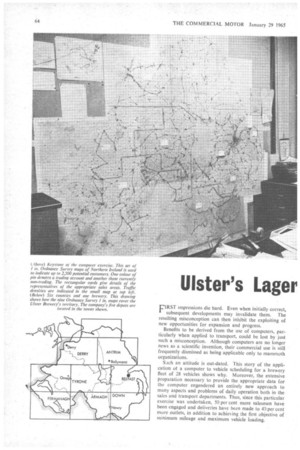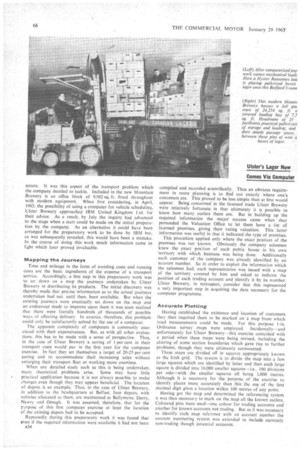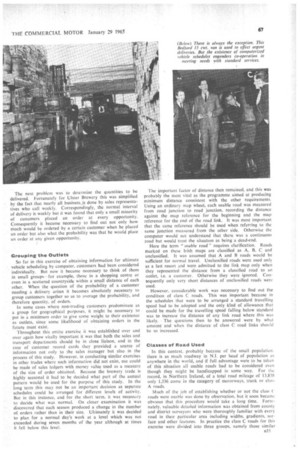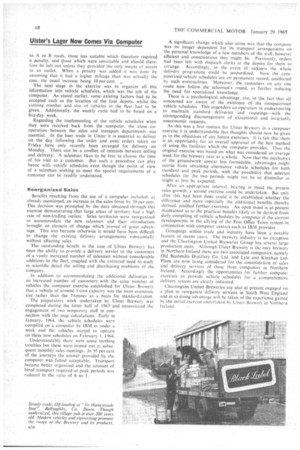Ulster's Lager low Comes Via Computer
Page 66

Page 67

Page 68

Page 69

Page 70

If you've noticed an error in this article please click here to report it so we can fix it.
Preparation for vehicle scheduling by computer for the 28-vehicle fleet of Ulster Brewery Co. Ltd. has brought associated benefits from unexpected quarters
By S. BUCKLEY, ASSOC. INST. T.
FERST impressions die hard. Even when initially correct, subsequent developments may invalidate them. The resulting misconception can then inhibit the exploiting of new opportunities for expansion and progress.
Benefits to be derived from the use of computers, particularly when applied to transport, could be lost by just such a misconception. Although computers are no longer news as a scientific invention, their commercial use is still frequently dismissed as being applicable only to mammoth organizations.
Such an attitude is out-dated. This story of the application ot a computer to vehicle scheduling for a brewery fleet of 28 vehicles shows why. Moreover, the extensive preparation necessary to provide the appropriate data for the computer engendered an entirely new approach to many aspects and problems of daily operation both in the sales and transport departments. Thus, since this particular exercise was undertaken, 50 per cent more salesmen have been engaged and deliveries have been made to 49 per cent more outlets, in addition to achieving the first objective of minimum mileage and maximum vehicle loading.
But first a look at the background to this particular exercise, with possibly an indication of common problems that are likely to be found by transport operators in other trades or territories.
As breweries go the Ulster Brewery Co, Ltd., Belfast, is unusual if not unique. Under this title it was incorporated as recently as July, 1950. In further contrast to century-old breweries in competition with one another on the mainland, Ulster Brewery is the only one in Northern Ireland. But to balance this illusion of monopoly it does not own a single public house. Almost all licensed premises in N.I. are free— free to use competing wholesale suppliers of products brewed outside N.I. if they so wish. And there are around 2,500 of these "outlets "—every one a potential customer or competitor's agent. All of which has a fundamental effect on sales and distribution policy.
Because Ulster Brewery is a relatively new company, all concerned in production and distribution have the advantage of working in the modern Mountain Brewery, completed in November, 1962. at a cost of £500,000. Thus, in contrast to corresponding premises in some older breweries, the covered loading bay has an area of 7,722 sq. ft. The full goods store has 21 ft. clear headroom to permit palletization of storage and subsequent loading by fork-lift truck. Here a pallet consists of 49 boxes (or 98 dozen of half-pint bottles) weighing 161 cwt. when full. Incidentally, a peculiarity and an added problem of the trade in N.I. are the varying shapes of half-pint bottles, making bottling, storage and loading more complex.
Offsetting the advantages of new premises and mechanized loading is the continuing problem of providing an efficient delivery service to 2.500 potential customers in an area so sparsely populated as Northern Ireland. The six counties— Antrim, Down, Armagh, Fermanagh, Tyrone and Derry— comprise an area of 5,462 sq. miles. But the population is only 14m., giving a density of 272 persons per sq. mile, compared with around 810 for England and Wales. Deduct the area of Belfast with its population of 413,900 and the contrast is even greater.
This, then is the area of distribution to be served by Ulster Brewery, together with an indication of the problems peculiar to the company and locality. But what triggered off the initial interest and subsequent decision to use a computer to achieve maximum efficiency in vehicle scheduling?
The answer disposes of yet another possible misconception. arising from recent trends overtaking practice previously accepted as so typically traditional as Irish stout. In the brief period of four years, lager has become a top seller in N.I. and Ulster Brewery has been the principal agent in this virtual revolution within the licensed trade of Ulster. This arose with the company being appointed bottler and distributor for Carling Black Label in Northern Ireland in 1960. The enormous benefit of selling a national brand was quickly realized. Sales rose so rapidly that existing facilities became inadequate. So the new Mountain Brewery was built.
This sales growth continues. But transport costs rise at such a rate that they could overtake the sales growth in a few years. So Ulster Brewery have decided to do something about it.
As a company in the Charrington United Breweries Group. budgets are prepared for all activities in advance. With Ulster Brewery the budget for transport expense is one of the largcr overheads and the service must therefore be used economically. In a factory there are controlled conditions of operation and the operative has the advantage of the advice and guidance of his foreman throughout the day. But in transport the lorry driver has no assistance for most of his working day until his return. It was this aspect of the transport problem which the company decided to tackle. Included in the new Mountain Brewery is an office block of 9,902 sq. ft. fitted throughout with modern equipment. When first considering, in April, 1963. the possibility of using a computer for vehicle scheduling, Ulster Brewery approached IBM United Kingdom Ltd. for their advice. As a result, by July the inquiry had advanced to the stage when a start could be made on the initial preparation by the company. As an alternative it could have been arranged for the preparatory work to be done by IBM but. as was subsequently revealed, this would have been a mistake. In the course of doing this work much information came to light which later proved invaluable.
Mapping the Journeys Time and mileage in the form of standing costs and running costs are the basic ingredients of the expense of a transport service. Accordingly, a first step in this preparatory work was to set down on a map the journeys undertaken by Ulster Brewery in distributing its products. The initial discovery was thereby made that precise information as to the actual journeys undertaken had not. until then, been available. But when the existing journeys were eventually set down on the map and an endeavour made to improve upon them it was soon realized that there were literally hundreds of thousands of possible ways of eflecting delivery. In essence, therefore, this problem could only be satisfactorily solved by the use of a computer.
The apparent complexity of computers is commonly associated with their expensiveness. But, as with all other evaluations, this has to be made with a sense of perspective. Thus, in the case of Ulster Brewery a saving of 1 per cent in their transport costs would pay in the first year for the computer exercise. In 'fact they set themselves a target of 20-25 per cent saving and to accommodate their increasing sales without enlarging their transport fleet or working more overtime.
When any detailed study such as this is being undertaken. many theoretical problems arise. Some may have little practical application because it is not always possible to make changes even though they may appear beneficial. The location of depots is an example. Thus. in the case of Ulster Brewery, in addition to the headquarters at Belfast, four depots, with vehicles allocated to them, are maintained at Ballymena. Derry, Newry and Omagh. It was assumed, therefore, that for the purpose of this first computer exercise at least the location of the existing depots had to be accepted.
Repeatedly during this preparatory work it was found that even if the required information were available it had not been 834 compiled and recorded scientifically. Thus an obvious requirement in route planning is to find out exactly where one's customers are. This proved to be less simple than at first would appear, Being concerned in the licensed trade Ulster Brewery were relatively fortunate in that ultimately it is possible to know how many outlets there are. But in building up the required information the major success came when they persuaded the Valuation Office to let them have a list of licensed premises, giving their rating valuation. This latter information was useful in that it indicated the type of premises.
This procedure applied only where the exact position of the premises was not known. Obviously the company salesmen knew the exact position of each public house in his own territory with which business was being done. Additionally each customer of the company was already identified by an account number. So in order to exploit the information which the salesmen had, each representative was issued with a map of the territory covered by him and asked to indicate the position of each trading account and identify it by its number. Ulster Brewery, in retrospect, consider that this represented a very important step in acquiring the data necessary for the computer programme.
Accurate Plotting Having established the existence and location of customers they then required them to be marked on a map from which road measurements could be made. For this purpose 1-in. Ordnance survey maps were employed. Incidentally—and unfortunately for Ulster Brewery—this exercise coincided with a period when these maps were being revised, including the altering of some section boundaries which gave rise to further problems, though they were ultimately surmounted.
These maps are divided off in squares appropriately known as the Irish grid. The system is to divide the map into a few large squares which are identified by letter and then each large square is divided into 10.000 smaller squares—i.e., 100 divisions per side—with the smaller squares all being 1,000 metres. Although it is necessary for the purpose of the exercise to identify places more accurately than this the use of the first decimal digit gives a location within 100 metres of any point.
Having got the map and determined the referencing system it was then necessary to mark on the map all the known outlets. Coloured pins were used—one colour for trading accounts and another for known accounts not trading. But as it was necessary to identify each map reference with an account number the account numbering system was extended to include currently non-trading though potential accounts. The next problem was to determine the quantities to be delivered. Fortunately for Ulster Brewery this was simplified by the fact that nearly all businessjs done by sales representatives who call weekly. Correspondingly, the normal interval of delivery is weekly but it was found that only a small minority of customers placed an order at every opportunity. Consequently it became necessary to find out not only how much would be ordered by a certain customer when he placed an order but also what the probability was that he would place an order at any given opportunity.
Grouping the Outlets So far in this exercise of obtaining information for ultimate vehicle scheduling by computer, customers had been considered individually. But now it became necessary to think of them in small groups—for example, those in a shopping centre or even in a scattered countryside within a small distance of each other. When the question of the probability of a customer needing a delivery arises it becomes absolutely necessary to group customers together so as to average the probability, and therefore quantity, of orders.
In some cases where non-trading customers predominate as a group for geographical purposes, it might be necessary to put in a minimum order to give some weight to their existence as outlets, since some likelihood of obtaining orders in the future must exist.
Throughout this entire exercise it was established over and over again how vitally important it was that both the sales and transport departments should be in close liaison, and in the case of customer record cards they provided a source of information not only to the sales manager but also in the process of this study. However, in conducting similar exercises in other trades where such information did not exist, use could be made of sales ledgers with money value used as a measure of the size of order obtained. Because the brewery trade is highly seasonal it had to be decided what part of the annual pattern would be used for the purpose of this study. In the long term this may not be an important decision as separate schedules could be arranged for different levels of activity. But in this instance, and for the short term, it was necessary to decide what was normal. On closer examination it was discovered that each season produced a change in the number of orders rather than in their size. Ultimately it was decided to plan for a normal day's work at a level which was not exceeded during seven months of the year although at times it fell below this level.
The important factor of distance then remained, and this was probably the most vital as the programme aimed at producing minimum distance consistent with the other requirements. Using an ordinary map wheel, each usable road was measured from road junction to road junction, recording the distance against the map reference for the beginning and the map reference for the end of the road link. It was most important that the same reference should be used when referring to the same junction measured from the other side. Otherwise the computer would not understand that there was a continuous road but would treat the situation as being a dead-end.
Here the term " usable road " requires clarification, Roads marked on these Irish maps are classified as A, B. C and unclassified. It was assumed that A and B roads would be sufficient for normal travel. Unclassified roads were used only as a last resort and were admitted to the link map only when they represented the distance from a classified road to an outlet, i.e. a customer. Otherwise they were ignored. Consequently only very short distances of unclassified roads were used.
However, considerable work was necessary to find out the condition of class C roads. This was important because in the schedules that were to be arranged a standard travelling speed had to be adopted and the only kind of allowance that could be made for the travelling speed falling below standard was to increase the distance of any link road where this was likely. The questions then to be answered were by what amount and when the distance of class C road links should be so increased.
Glasses of Road Used In this context, probably because of the small population. there is as much roadway in N.I. per head of population as anywhere in the world, and if full advantage were to be taken of this situation all usable roads had to be considered even though they might be handicapped in some way. For the record, in Northern Ireland, of a total road mileage of 13,838 only 1,336 come in the category of motorways, trunk or class A roads.
Much of the job of establishing whether or not the class C roads were usable was done by observation, but it soon became obvious that this procedure would take a long time. Fortunately. valuable detailed information was obtained from county and district surveyors who were thoroughly familiar with every road in their particular area including widths, gradients, surface and other features. In practice the class C roads for this exercise were divided into three groups, namely those similar
to A or B roads, those less suitable which therefore required a penalty, and those which. were unsuitable and should therefore be left out unless they provided the only means of access to an outlet. When a penalty was added' it was done by assuming that it had a higher mileage than was actually the case. the usual increase being 10 per cent.
The next stage in the exercise was to organize all this information into vehicle schedules, which was the job of the computer. As stated earlier, some existing factors had to be accepted such as the location of the four depots, whilst the existing number and size of vehicles in the fleet had to he given. Additionally, the weekly cycle had to be based on a five-day week.
Regarding the implementing of the vehicle schedules when they were received back from the computer, the close cooperation between the sales and transport departments was essential. In the beer trade in Ulster it is essential to deliver on the day following the order and even orders taken on Friday have only recently been arranged for delivery on Monday. There can be a conflict of interests between selling and delivery. A salesman likes to be free to choose the time of his visit to a customer. But such a procedure can play havoc with vehicle schedules even though the point of view of a salesman wishing to meet the special requirements of a customer can be readily understood.
Reorganized Sales Benefits resulting from the use of a computer included, as already mentioned, an increase in the sales force by 50 per cent. This decision was prompted by the data obtained through this exercise demonstrating that large areas of territory had a high rate of non-trading outlets. Sales territories were reorganized to accommodate the new salesmen and their introduction brought an element of change which proved of great advantage_ This was because otherwise it would have been difficult to change the existing delivery arrangements sobstantially without affecting sales.
The outstanding benefit in the case of Ulster Brewery has been the ability to pi ovide a delivery service to the customers of a vastly increased number of salesmen without considerable additions to the fleet, coupled with the enforced need to study in scientific detail the selling and distributing problems of the company.
In addition to accommodating the additional deliveries to an increased number of customers with the same number of vehicles the computer exercise established for Ulster Brewery that a vehicle of around 5 tons capacity was the most economic size rather than the 7-tonner as a basis for standardization.
The preparatory work undertaken by Ulster Brewery was completed during the latter half .of 1963, and necessitated the engagement of two temporary staff in connection with the map calculations. Early in January, 1964, the vehicle schedules were compiled on a computer by IBM in under a week and the vehicles started to operate on these new schedules on February 1, 1964.
Understandably there were some teething troubles but these were ironed out at subsequent monthly sales meetings. In 95 per cent of the journeys the answer provided by the computer was foand acceptable. Transport became better organized and the amount of hired transport required at peak periods was reduced in the ratio of 6 to 1. A significant change which also arose was that the company was no longer dependent for its transport arrangements on the personal knowledge of a few members of the staff, however efficient and conscientious they might be. Previously, orders had been left with dispatch clerks at the depots for them to arrange. Accordingly, in the event of sickness the whole delivery programme could be jeopardized. Now the computerized vehicle schedules are on permanent record, unaffected by such eventualities. Moreover, the customers on any one route now follow the salesman's round, so further reducing the need for specialized knowledge.
There is a psychological advantage. too, in the fact that all concerned are aware of the existence of the computerized vehicle schedules. This engenders co-operation in endeavouring to maintain standard deliveries and routeings—with the corresponding discouragement of exceptional and invariably uneconomic requests.
As this was a first venture for Ulster Brewery in a computer exercise it is understandable that thoughts 'should now be given as to the objectives of any future exercises. !Cis felt that there is an opportunity for an overall appraisal of the best method of using the facilities which the computer provides. Thus the original exercise was based on what was considered an average week for the brewery year as a whole. Now that the mechanics of the groundwork appear less formidable, advantages might accrue from obtaining alternative vehicle schedules for both standard and peak periods, with the possibility that selected schedules for the two periods might not be so disSimilar as might at first be expected.
After an appropriate interval, bearing in mind the present sales growth, a second exercise could be undertaken, But only after this had been done could it be established whether the difference and more especially the additional benefits thereby derived, justified further exercises. An open mind is at present maintained as to the practical benefits likely to be derived from daily compiling of vehicle schedules by computer if the current developments in the allying of the Post Office ',Telex system in conjunction with computer centres such as IBM provides.
Groupings within trade and industry have been a notable feature of recent years. The brewery industry is no exception and the Charrington United Breweries Group has several large production units. Although Ulster Brewery is the only brewery in Northern Ireland there are two associated companies, namely Old Bushmills Distillery Co. Ltd, and Lyle and ICinahan Ltd. Plans are now being considered for the consolidation of sales and delivery services of these three companies in Northern Ireland. Accordingly the opportunities for further computer exercises to provide vehicle Schedules for a comprehensive delivery system are clearly indicated.
Charrington United Breweries are also at present engaged on a plan to reorganize delivery services in South West England and in so doing advantage will be taken of the experience gained by the initial exercise undertaken by Ulster Brewery in Northern Ireland.




















































































































